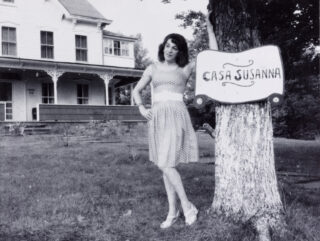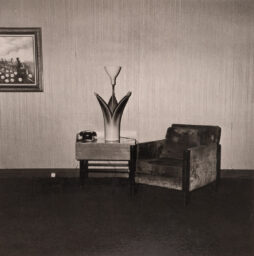Robert Cumming, R. Cumming in a Car, Chicago, 1976
In 2016, Aperture published The Difficulties of Nonsense, the first comprehensive publication to survey Robert Cumming’s significant series of conceptual black-and-white and color photographs from the 1970s, now a touchstone for contemporary artists, and focus on the artist’s fascination with illusion and trickery. From his base in Los Angeles, Cumming made functional-looking but ultimately useless constructions, created primarily to be photographed with his 8 x 10 camera. Playing with props, proportions, unusual angles, light and mirrors, Cumming invited viewers to look in—and then to look again, second-guessing what they saw. On the occasion of Cumming’s death in December 2021, we revisit David Campany’s interview with the photographer, who playfully pushed the boundaries of image and narrative.
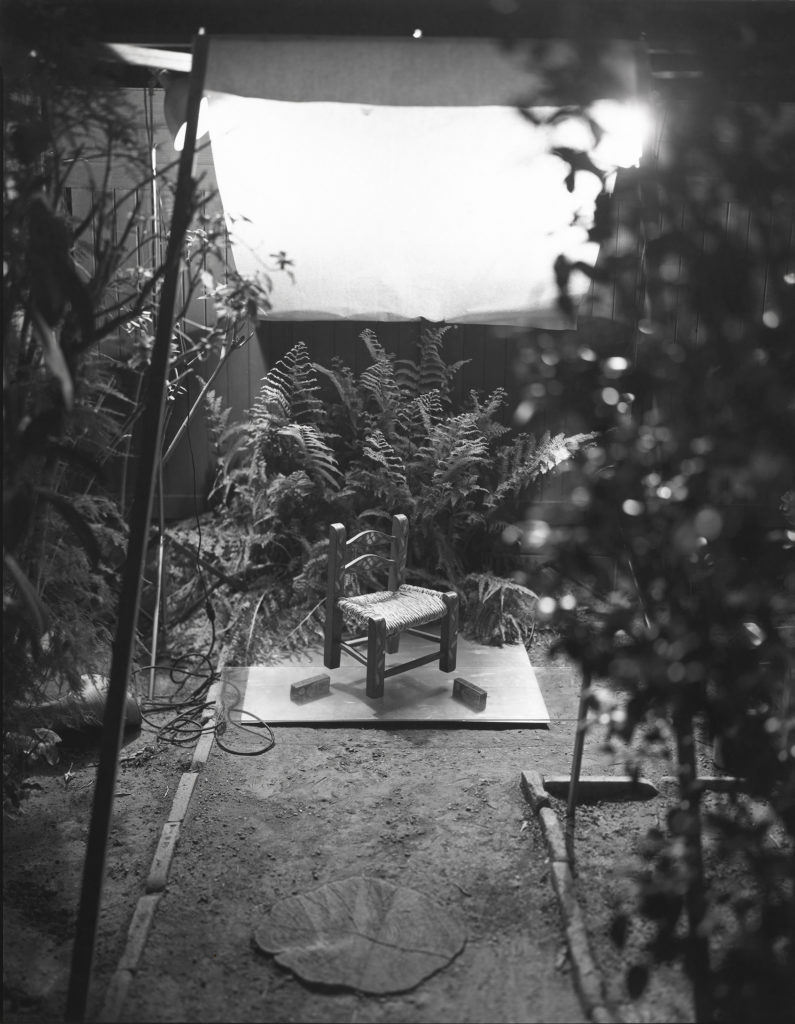
David Campany: Robert, you made your photographic work pretty intensively for a decade or so, and then moved on to other things, but the ground you covered was very rich. Are you the same person now who made that work? Do you relate to it as yours?
Robert Cumming: Yeah, it does feel like mine.
Campany: There’s a lot of energy in the work. So many of the pictures are very labor-intensive.
Cumming: To start off an idea, I would do a drawing, like a little pencil sketch. And I had made a promise to myself never to act on these ideas until I’d waited at least a month. I think about one drawing in five was actually made into a photograph. It was a good discipline for me because, you know, the newest idea was always fantastic, and I’d launch into this complicated prop and then realize in the middle, “This really sucks—what was I thinking?” So there was a pact to let each one simmer first as a drawing.
Campany: But do you think that something that works as a drawing might not work as a photograph, or the other way around?
Cumming: Yeah, that would happen. But this waiting helped me understand which path to take.
Campany: There are so many translations going on: idea into drawing, then drawing into objects or situations, and then into a photograph. And you need to be keeping an eye on all of those translations to get somewhere worthwhile. I wouldn’t have been able to say so at the time, but I remember when I first saw your work there was something about the visual qualities of the pictures: they seemed so unlikely with the subject matter and the working process. I know it’s overstated that conceptual artists weren’t interested in craft, but your photographs had such a fascination and affection for the finest qualities of the photographic print.
Cumming: It’s true. But I had by that time really studied photography and its history, and I got more and more taken in by it.

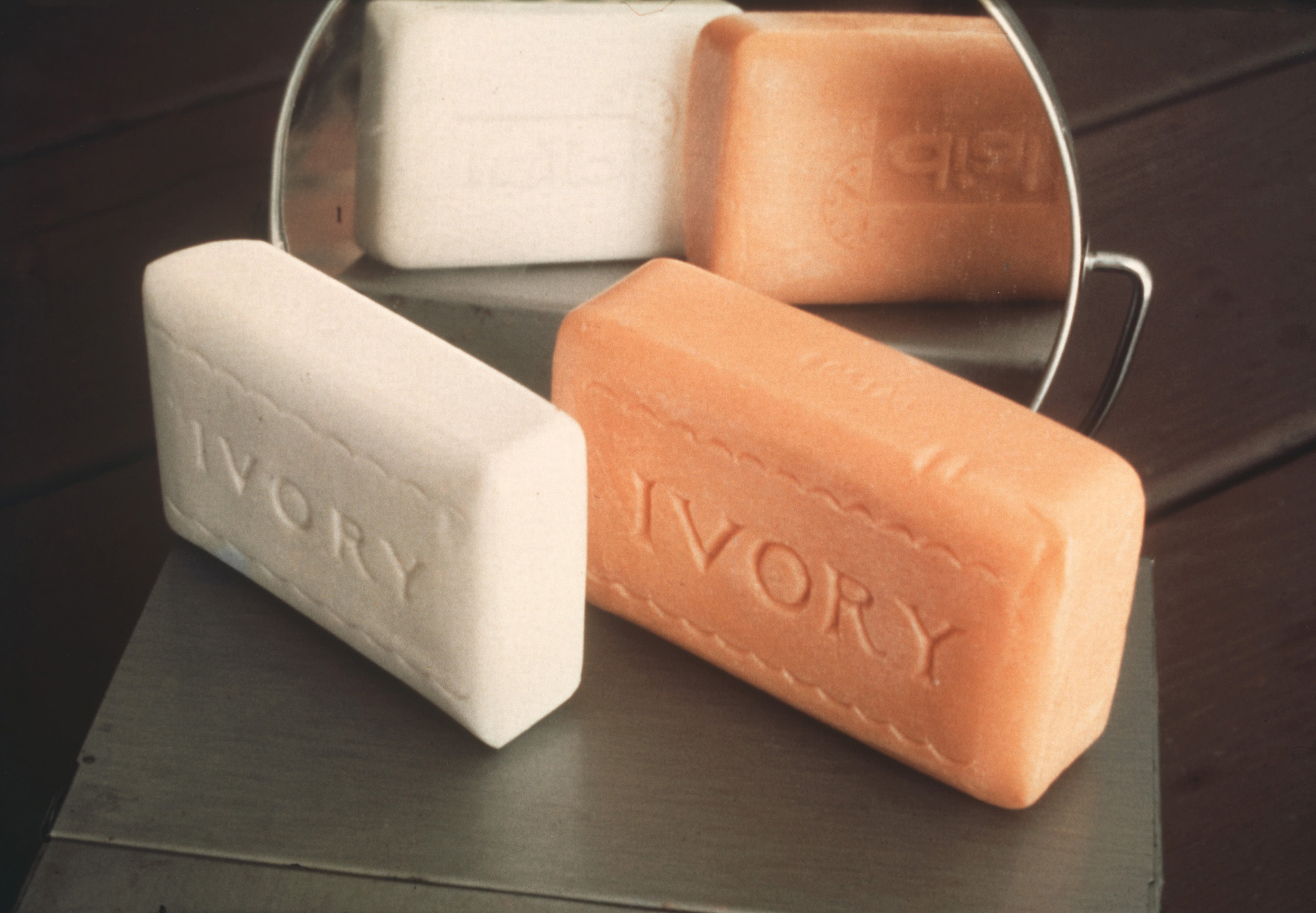
Campany: You were a real bridge back then between what they used to call “photographers” and “artists using photography.”
Cumming: I’m sort of in the middle there. And my exhibitions were like that, too. I did some sculpture shows, some conceptual art shows, and some photographic exhibitions as well.
Campany: Did you go straight to the 8-by-10 camera?
Cumming: Well, I started with a little Instamatic in undergraduate school. I was taking reference pictures mainly as, I don’t know, studies for drawings I was doing.
Campany: Notations.
Cumming: Notations. Notations for these big industrial landscapes—what locomotive roundhouses looked like, that sort of thing. In undergraduate school from 1961 to 1965, in our photography class, we were learning how to use 4-by-5 cameras. Then in graduate school, although it was a supposed elective, it was strongly pressed on us that it would be a good thing for us to do large-format work. I really didn’t like it, but later, when I was out of school, I thought, Jeez, I kind of miss this. I bought a 5-by-7 because I couldn’t see lugging an enormous 8-by-10 around. But it was stolen from my car, which was great because there were no supplies. Getting film for 5-by-7 was almost impossible; I had taken maybe thirty, forty pictures on it. I then bought an 8-by-10 Burke & James, which was the main recording device through about 1980.
Campany: Did you do all your own darkroom work?
Cumming: Oh, yes.
Campany: And you were exhibiting 8-by-10 contact prints?
Cumming: Usually, yes.
Campany: I was talking to Stephen Shore recently about the necessary discipline of using an 8-by-10. He felt it was kind of cosmic because there’s more information than you could ever possibly want.
Cumming: Sure, that’s sort of why I use it.

Campany: On the one hand, the pictures have this very demonstrative, playful, pedagogical dimension. But when you use an 8-by-10, you have a great surfeit of visual information that exceeds those meanings. It’s just this huge richness that’s . . . there, surplus to any obvious requirement.
Cumming: There were very few exhibitions, catalogues, or books on photography when I started. Art Sinsabaugh was our instructor [in graduate school], a purist whose aesthetic I had no use for; at that point I wanted to do 35 mm collages that I’d make into silkscreens à la Rauschenberg. We had a bumpy two years together. But I’d slowly gotten sucked into this big negative thing. To backtrack just a little, it was sculpture that first prompted me to make the photographs back in Milwaukee in the late 1960s.
Campany: You were documenting your sculpture?
Cumming: If you did sculpture and entered sculpture competitions or juried shows, you had to send photos. Sculpture is just too big and heavy. I always thought I had an unfair advantage because I could take a picture that could often be better than the actual piece. And in some cases other artists who did much better sculptures weren’t juried into the shows—on the basis of their skills as photographers. I shot everything with the new 8-by-10.
Campany: Well, that problem has only got worse. We live in an art culture that’s just full of reproductions. Sometimes I think all art culture has ended up being photographic, whether it was photographic originally or not. We see so much in magazines and on websites.
Cumming: At some point, I was just happier with the photograph than the sculpture. And I could photograph them in different positions and in different locations, not just in the studio, and embellish the lighting.
Campany: You were making very photogenic sculptures somehow.
Cumming: Well, the sculpture and the photography certainly fed off each other.
Campany: Sculptures, Milwaukee [1968] reminds me of some of the pictures that Larry Sultan and Mike Mandel ended up with in their book Evidence, which was published almost a decade later, I think. The photograph as factual enigma.
Cumming: I used to know them, though not very closely. All the artists from LA would wind up at the same shows eventually, at the same openings.
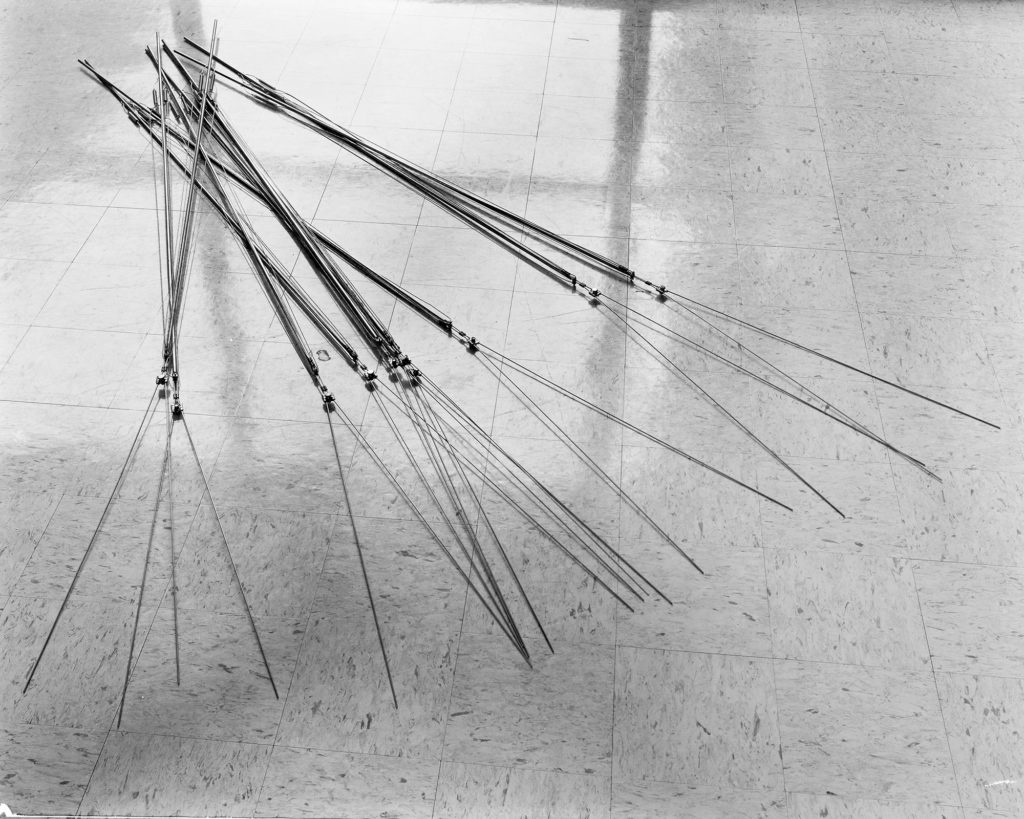
Campany: I was reading somewhere that you kept your distance from the art world. Was that just a temperamental thing?
Cumming: That also describes my current situation.
Campany: There’s something so individual about your work and the pursuit of the making of it. It’s isolated but it’s informed. You’re not completely in a world of your own, but you want a freedom and space that’s yours.
Cumming: That’s how it’s been, definitely.
Campany: Although you went to art school, I sense the heart of your learning is more self-taught, more autodidactic. I don’t know what I would base that on, but just looking at the work it seems that way.
Cumming: Pretty much. None of our classes taught assembled, “additive” sculpture; everyone was chipping away at wood or stone, molding clay—“reductive” sculpture. I wanted to put things together with screws and nails, maybe weld. Even out of graduate school, I couldn’t screw wood together properly; I had very few tools. But I wanted my objects to look like things from the real world, stuff you’d find in hardware stores: rakes, springs, brush cutters, prosthetic devices, etc. Very soon my sculptures took on that language. I liked learning how to do practical things, from the manual. Every year I’d learn a new trade: how to sew, type, weld . . .
Campany: It’s interesting that the sculptures, kind of like the photography, begin with something utilitarian and then end up being useless. Or contemplating utility without being useful!
Cumming: Yeah, exactly.
Campany: In some ways your photography is very pure and seems to be an investigation of the properties or qualities of a distinct medium. Against that notion, you arrived at photography because it’s where all of your interests can come together—the writing, painting, sculpture, performance, handiwork, and the problem-solving. There’s something about the way photography can be a kind of container for all of those things.
Cumming: In the beginning, many of my pictures were like one-liners. Easy. Once you saw them, you thought, OK, very amusing. But at a certain point, very early on, I realized I wanted to make more complicated pieces that would read more slowly. In other words, you’d get the main point, but then in time, on closer inspection, this other stuff would creep in from the margins, changing contexts and meanings, making the story more complex.
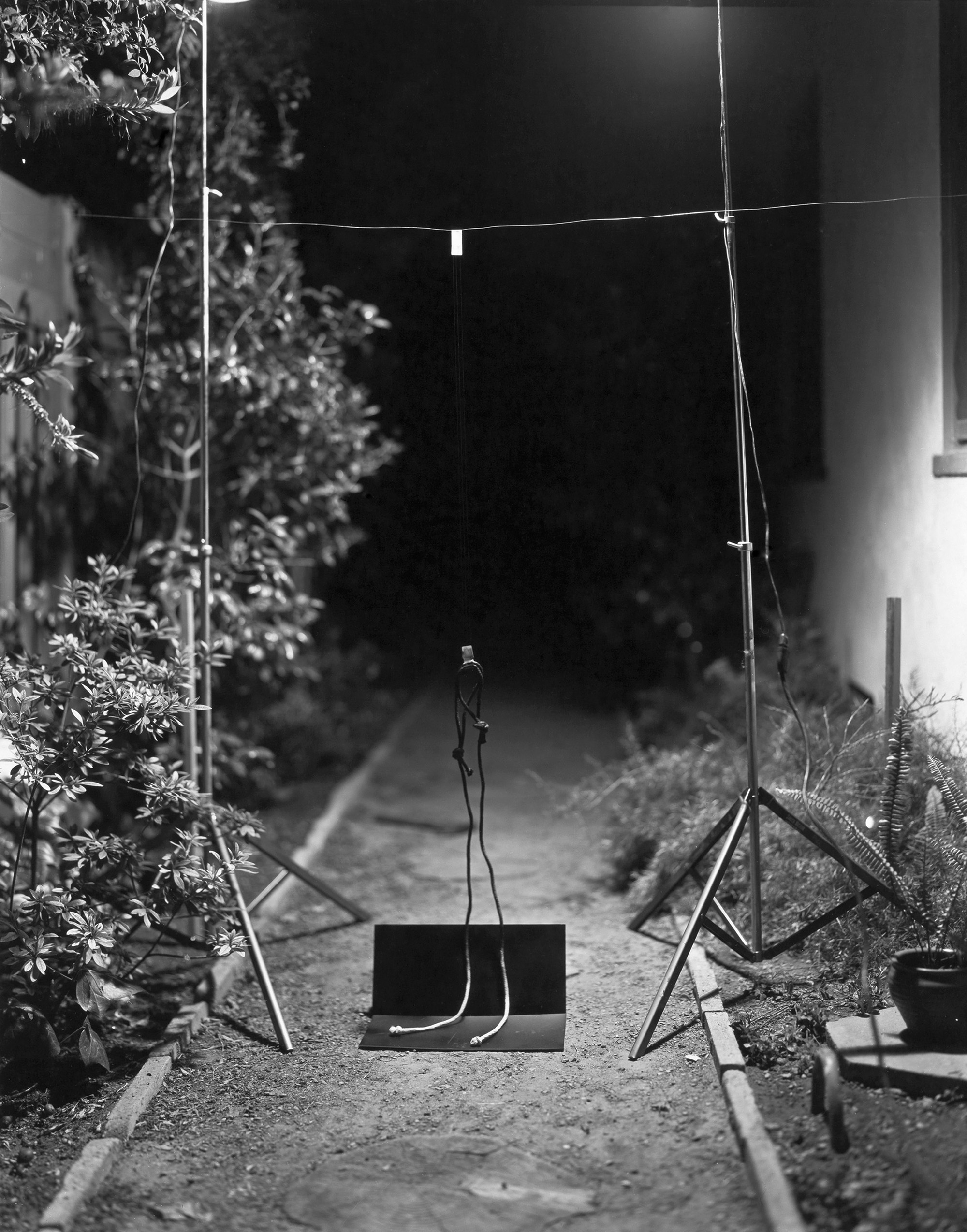
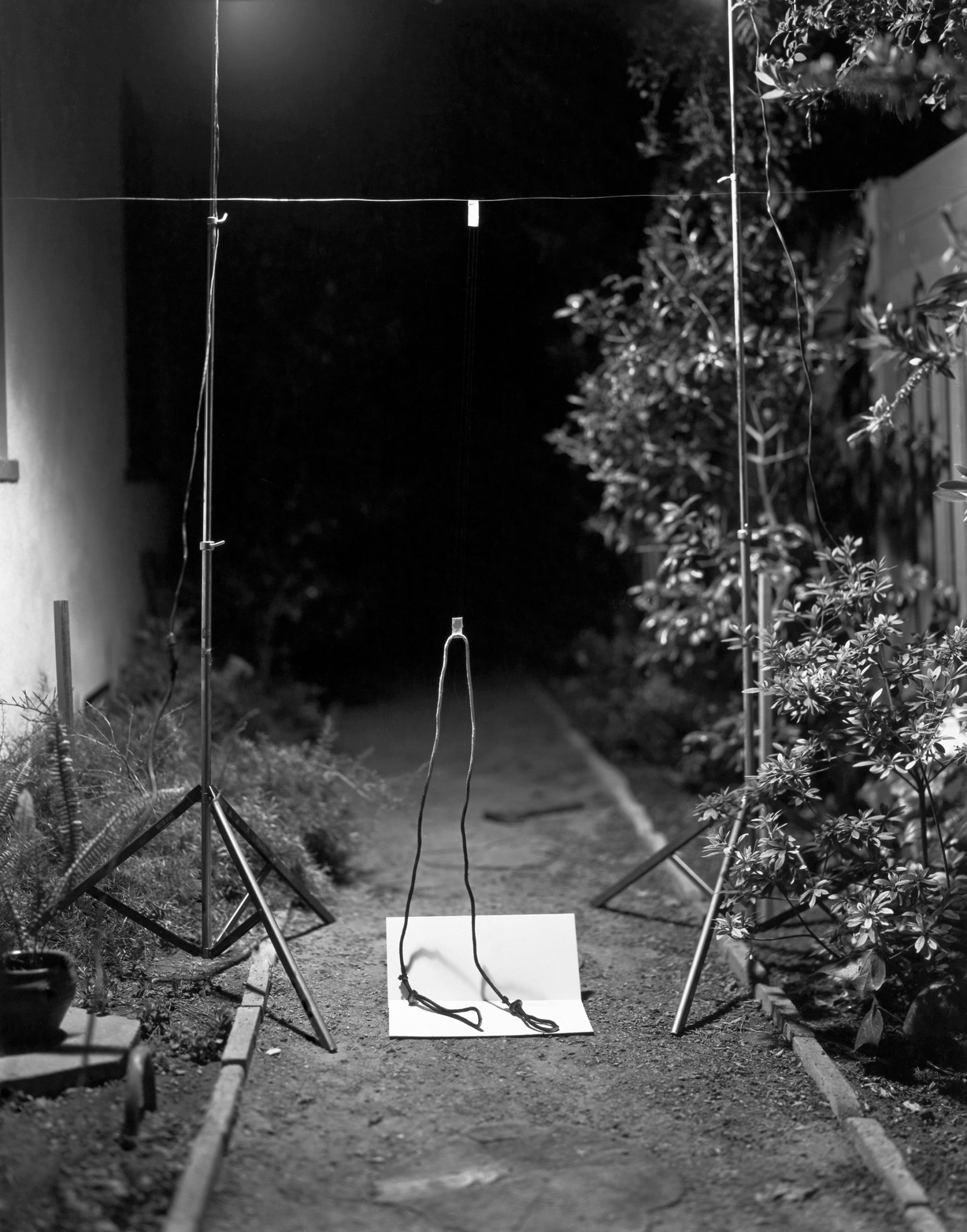
Campany: If you had been a die-hard conceptualist, I suppose you’d have been making all of your set-ups in a kind of blank white studio—
Cumming: Right, right.
Campany: But the world comes into your pictures. The backyards, the bits of interiors, or gardens at the margins.
Cumming: Yes. Often there’s a staging, as if these are little theater pieces. In Chair Trick [1973], the tiny “stage” is framed by my tiny backyard, only about four feet wide. It’s typical California-suburban.
Campany: But you want all of that extra stuff in the frame. It’s titled Chair Trick and there’s a trick going on with the chair, but what you end up with is a picture about diffused lighting, about fauna, about backyards. There’s a whole world, rather than the mere execution of an idea.
Cumming: That’s right. It’s all in there deliberately. Actually, Chair Trick was one of the very first I made experimenting with the parameters of my backyard at night. Only a few feet away, a couple nights later, I made Black &White/White & Black Rope Trick [1973]. I had found this copper wire, fine as a spider’s web, that took three pieces to hold up just the one foot-long length of clothesline rope. I wanted to see if the wire would show in an 8-by-10 contact print, which it did.
Campany: That’s amazing. Do you like magic? Close-up magic? Looking at these kinds of photographs is a little bit like watching somebody very consummate perform a magic trick in front of your eyes.
Cumming: Yes, the pictures would give away the trick, I think.
Campany: There’s often a tension between something that the title tells you to look at and something less specific to be thought about.
Cumming: And sometimes my titles are intentionally misleading.
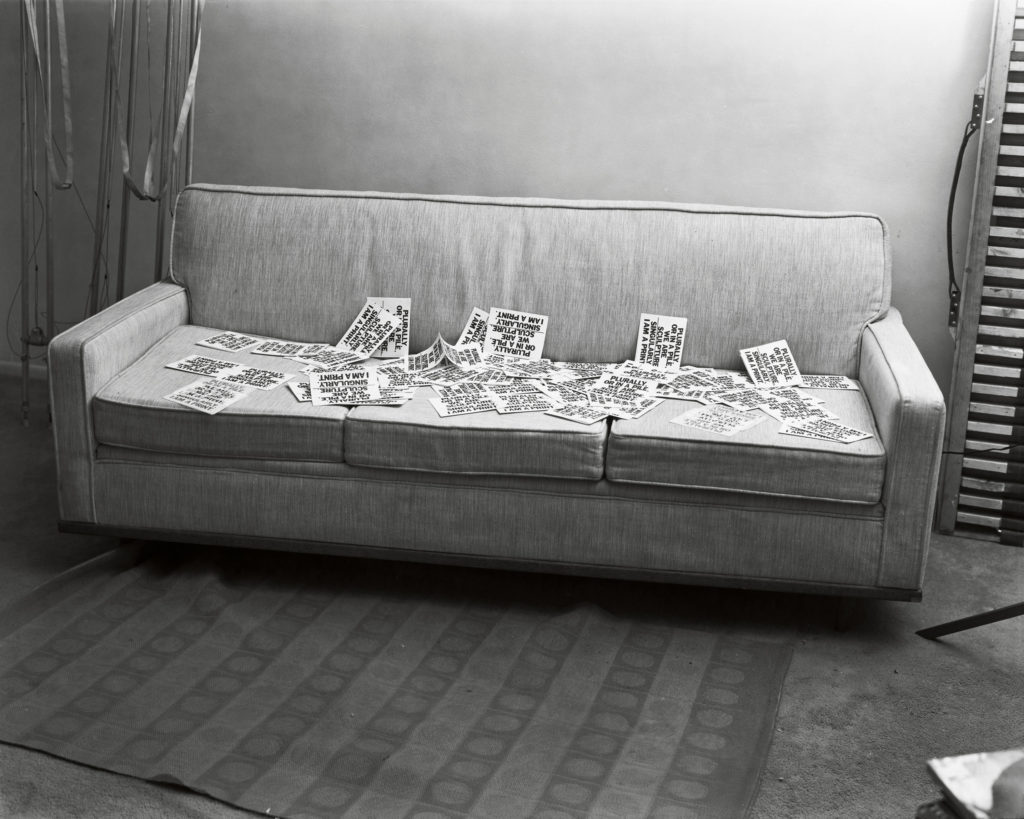
Campany: You made a piece called 120 Alternatives [1970], which shows a sofa on which you scattered 120 identical pieces of paper.
Cumming: Yes, the text on the paper reads: “Plurally or in a Pile We Are Sculpture / Singularly, I Am a Print.”
Campany: I really like it as an image. It’s so much more than idea. The photographic print is very fine, with all those shades of gray. The angle is strange. You have to strain a little to read the text. Why is it that sofa? Is that the leg of a light stand?
Cumming: A light stand left in on purpose. William Wegman and I were close for about ten years—as undergrads at Mass Art, roommates at Illinois, teaching in Wisconsin, and sharing a studio in Milwaukee for a couple years, before winding up in Southern California around 1970. His take on it was something like, “Cumming, you shouldn’t be giving away all your tricks. You should stash all your sets and props in a big warehouse, then after you die they’ll be found and it’ll be revealed what a big hoax your pictures were.” But for me, the whole point was the slow discovery of how the illusions worked.
Campany: The pictures are not about the riddle of how it was done. They are much more about the fact that it was done.
Cumming: Exactly. The funny thing is, for all the information, all the detail and complexity, me talking about them—you can describe them to death and you’re ultimately just not closer to what they’re really about.
Campany: It’s an incredibly rich period, Californian photography of the 1970s. Quite rightly there’s still a lot of interest in what went on back then. I discovered it as a student in London in the early 1990s, looking for catalogues of long-gone West Coast group shows.
Cumming: [Laughs]
Campany: There was something about European conceptualism that always seemed a little too dry for its own good. Maybe there was something about sunshine that kept people humorous!
Cumming: The sunshine is supposed to melt your brains [laughs].
Campany: Well, there’s more irony in West Coast work of that time. Or there’s a kind of understanding that humor is a profound and intellectual thing. It’s not the enemy of seriousness; it’s another path toward it. In hindsight, what do you think about that period, making those 8-by-10s?
Cumming: It’s hard to encapsulate. I was working like a maniac—sort of burning the candle at both ends.
Campany: Where did that energy come from? Did you feel you were searching for something?
Cumming: Well, part of it was practical. It was a difficult period. California art departments weren’t putting on any new full-time faculty, which was my main source of income. I had to work more jobs to support the artwork, and because I was doing more shows, needed more paying work, etc., etc. I was working all the time; eight art schools in eight years, janitor, sign painter, visiting artist gigs, lectures, etc. It peaked in 1980 with thirty exhibitions, fourteen lectures, a couple portfolios, and a government jury for the National Endowment for the Arts.
Campany: Were you selling any work?
Cumming: Basically, no. The work all went out to shows and all came back. Making matters worse, my first New York dealer, John Gibson, seldom paid us for work he sold. He was also the one who insisted I make editions of two or three, which I’ve been saddled with to this day.
Campany: Do you know which museums or collectors have your work?
Cumming: Around 1982, a Chicago collector bought one version of everything—230 prints—and donated them to four museums. So I know exactly where they are.
Campany: I’ve hardly seen any of your work in exhibition. I think I only know it through publications. I know the prints themselves will always be far richer than any reproduction.
Cumming: Someone came up to me after a slide lecture and said, “You know that’s just a trick to get people to come to your shows, telling them all the stuff you can only see in the contact print.” [Laughs]
Campany: I teach students at the moment, and I show them your work and they’re shocked when I tell them the dates of your pictures. It feels very contemporary to them.
Cumming: Maybe it’s because the work looks deconstructive.

Campany: It might be that. I think in the last five or so years there’s been an opening up again between photography and other media. At the same time, there’s a real interest in the craft of making pictures. So again your work is that kind of bridge we were talking about at the beginning. I think students today probably see something of that—relating to the photographs pictorially, and as explorations of ideas. There’s real synergy between those two aspects. There’s also a spirit that mixes the very logical and the slightly mad. Your photographs are analytical studies that are also arcane and ritualized and obsessive.
Cumming: Oh, good! [Laughs]
Campany: Let’s talk a little about your making books. The books were the place where you put your different investigations together—the photographs and the writing—and in books they became more than the sum of their parts.
Cumming: Maybe the self-publishing was just ego. My first book, Picture Fictions [1971], was a compilation of work through 1971. The second, The Weight of Franchise Meat [1971], I really hate. I just ran too quickly with a bad idea.
Campany: Did you approach the making of books as another discipline to learn, or did you know anything about the process before?
Cumming: No—I got the idea, of course, from Ed Ruscha. He was very early on in the scene, if not the first, with Twentysix Gasoline Stations, and later with Royal Road Test, Thirtyfour Parking Lots in Los Angeles, and of course, Every Building on the Sunset Strip. The work is brilliant.

Campany: Did you know Ruscha at the time?
Cumming: I’d meet these people at openings every once in a while, but you know, not an awful lot more than a handshake. I knew his books were published by Heavy Industry Press, so on a lark, I sent some pictures with a note [that said], “Hey, would you like to print these, make them into a book?” I got a nice letter from a woman who said, “Well, basically Heavy Industry Press is Ed Ruscha’s printing company and does only his work. But good luck with your career.” So I thought I’d do the same thing: publish my own stuff, starting with one thousand copies, sell lots, send them out, and it would be wonderful. Then arrived the new boxes from the printer with that fresh smell of printer’s ink. Sitting there in the middle of the studio, I thought, “What now?”
Campany: Distribution is the thing.
Cumming: Distribution. I hadn’t even thought of distribution. Now I had to start being my own distributor. I started by charging $2.50 per copy. I’d drive halfway across the LA basin to one bookstore. The manager wouldn’t be in so I’d return home and come back on Thursday. He didn’t come in—he’d called in sick—so you’d have to come back a third time. By that time, after five hundred miles on the odometer through notorious LA freeway traffic, he’d buy three copies for $7 (asking for a special discount—$5.75). It was totally, totally hopeless.
In 1973 I did a book called A Training in the Arts with Coach House Press in Toronto, and they had a proper catalogue of titles and distribution. It actually went into reprint
in 1975.
Campany: You ended up doing three books with Coach House: A Training in the Arts, A Discourse on Domestic Disorder (1975), and Interruptions in Landscape and Logic (1977). Those books were very “writerly,” too.
Cumming: Well, they’re literary experiments in a way. The normal way an illustrated story operates is as a triad: illustration assists the text, assisted by the caption. All are connected. But I wondered what it would be like if one of the three connectors was clipped—if caption assisted illustration, but illustration didn’t connect with the story.

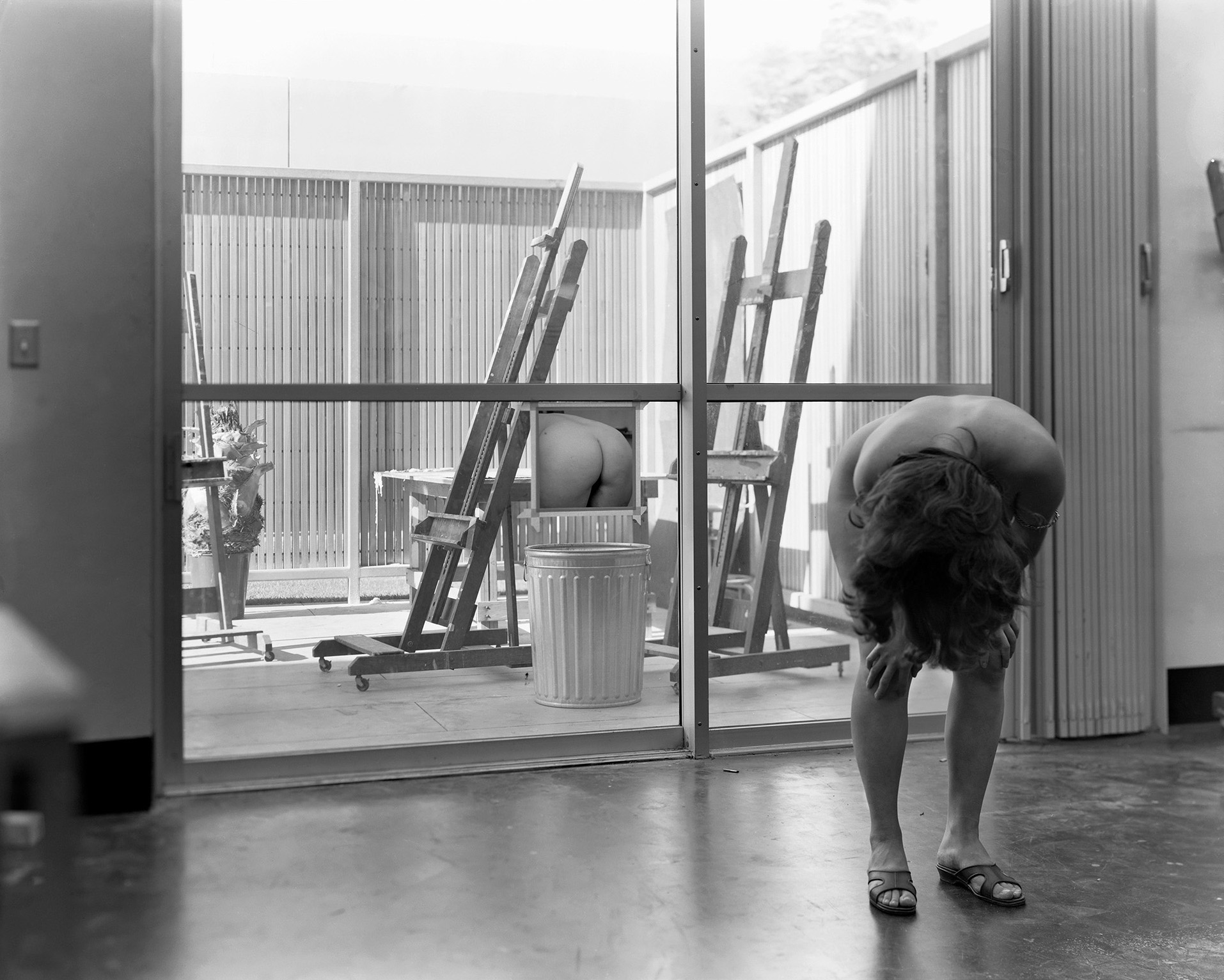
Campany: I can’t think of anyone else who would write in that kind of tone. It’s very consistent with your visual work.
Cumming: That’s perhaps true. Training in the Arts was a parody of Harlequin romance novels—the text is so . . . flat. I don’t know how else to describe [Harlequin books]; they’re just dead. Thousands of words lying there on a page . . . which seem to make millions of readers happy. Additionally, it parodied a couple I knew, art-education majors for whom every damned thing was a “tasting experience” or a “learning experience.” They had a way of leeching life out of everything that passed before them.
Campany: Your writing is a bit like your pictures. Flat-footed, informational prose can be very open for the reader—it gives them a lot of space. You don’t feel hectored or overly guided. It’s like the writing and theories of Alain Robbe-Grillet. Deadpan, uninflected writing can be a very generous writing. It doesn’t force emotions on the reader.
Cumming: I was very influenced by Robbe-Grillet.
Campany: You were? I sense there are many photographers who like his work. There are deep affinities. All those facts with no clear explanation!
Cumming: Yes, it takes us back to the idea that you can describe things endlessly and it’s still a mystery. Robbe- Grillet describes positions, topography—describe, describe, describe. But ultimately it lacks some sort of glue, doesn’t adhere, just kind of disintegrates. But that’s the point; it’s his kind of magic.
Campany: When it’s done really well, it’s extremely memorable. And even though the work is kind of anti- narrative, you can’t help but put it into your own narrative because humans are narrative beings.
Cumming: I love In the Labyrinth, Robbe-Grillet’s book with the soldier wandering around in a vacant city. It starts to snow. And the snow comes down and down and he walks into a tavern and there’s dust falling, and on the wall a print of a landscape, way in the background—a city? And the dust and the snow keep falling, glass rings in the dust…
Campany: In the short piece “The Dressmaker’s Dummy,” from the book Snapshots, he describes one room in great detail—objects, positions, angles of view—but eventually you realize that the room doesn’t add up. The description is illogical. I had to draw the room to figure that out.
Cumming: That’s a nice way to respond to writing—draw a picture!

Campany: A question I’ve always thought about in relation to your work, which never seems to come up anywhere in any of the writings—maybe we can talk about it in relation to your book Equilibrium and the Rotary Disc—is your relation to the art of Marcel Duchamp. The technical know-how, the strange allegories, the jokes, the balance between mystery and revelation.
Cumming: My work has been in a couple of shows that have tried to pair my work with Duchamp, but I really don’t feel a strong affinity for him, for some reason.
Campany: No?
Cumming: The last Cumming–Duchamp show I was in, a kind of Duchamp colloquium in Philadelphia, I finally figured out why . . . but I’ve forgotten [laughs]. It was complicated. If there’s been an artist I’ve had a lasting affection for, it’s probably Piranesi. There’s a lot of him in my stuff from back in the 1960s. His prisons and architectural studies of Rome—all that description, like intense needlework. He also pulls a lot of funny strings, reducing his figures to make their settings mightier than they really are.
Campany: Your rotary disc on a waterfall does remind me of Duchamp’s last work Étant donnés, but it also looks like a Max Ernst—a very lucid but unlikely vision from the nineteenth century. The viewer knows there’s a central thing going on in the presentation, but again it can’t be reduced to an idea.
Cumming: When I was working on Equilibrium and the Rotary Disc, between 1977 to 1978, I was thinking of moving out of California and going back East. Part of it was the growing dissatisfaction with illusion in the work. Growing up in New England, there was a nostalgia for its history: New England mill towns, the Industrial Revolution, and the smaller scale of the mill valleys. Enthusiasm for Hollywood was starting to wane. Also, I was tired of being poor, feeling that I was never going to make a decent living. The only chance in LA seemed to be something like starting up a studio for shooting celebrities, doing commercial work like Annie Leibovitz. But it was obvious I had to get closer to New York and connect with a New York gallery, and get closer to Europe, where there was a growing enthusiasm for American artists.
Campany: It’s hard to feel one’s own historical consciousness in a place like Los Angeles, where you’re surrounded by the present.
Cumming: Exactly. So this interest in the Industrial Revolution sparked a general renewal in history. I made drawings to show how mill towns evolved. The waterfall—the central source of energy—turned the water wheel, and the shafts and machinery inside. The workshops grew into factories, workers lived in row houses, and by the 1890s or 1900, the cities were pretty large. It was the evolution of the kind of towns I’d grown up in. I didn’t understand them until I’d been away from them ten or more years and had seen them from the very different perspectives of the Midwest and the West.
Campany: Your publications are not gallery artworks. They’re cheap and accessible. And there’s something very nice about the drawings and the writing and the painting and the photography all coming together on the printed page. I guess the issue is slightly different with the books that are more like artist’s books than catalogues, because in a way they are the work itself. But I always remember a kind of famous and probably apocryphal story about English abstract painters in the 1950s and ’60s: they were all making work that was never more than thirty inches wide or something, because they’d seen all of that great American abstract work in catalogues and had no grasp of the scale of the things at all.
Cumming: Which is really vital. Well, with my connection with Castelli Graphics and the burgeoning ’80s art market, the smaller drawings, after four shows, had grown increasingly, up to eight by ten feet. Then I started to realize the impracticality; they didn’t fit through doors, elevators, stairwells.
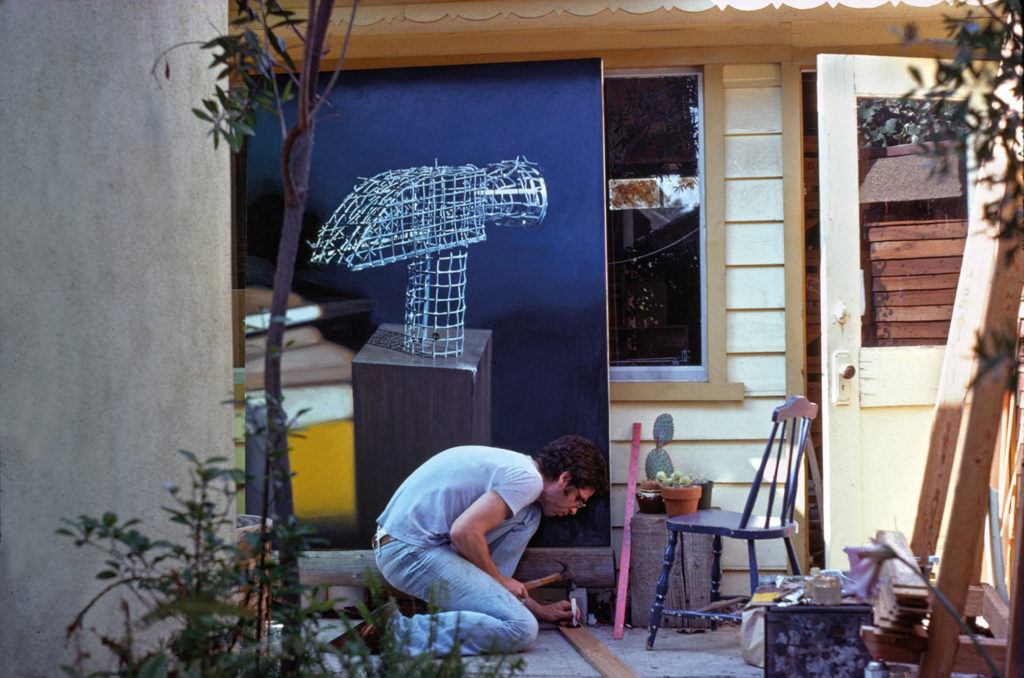
Campany: When did you join Castelli?
Cumming: Nineteen eighty-one or ’82, and went through about 1990. It was a wonderful gallery. Photography galleries had asked me about representation, but I wanted a gallery where I could do sculpture and photography, where I could do everything. Leo Castelli called me, and it was a fabulous solution. A dream come true. It came to an end when Mr. Castelli died. The ’80s art market was just crazy, with so much money flooding in and people buying anything. I did really well for about a five-year period in my life and got that out of my system, when I was with Castelli.
Campany: You did some very detailed paintings from your photographs.
Cumming: Oh, yeah.
Campany: Amazing. For some people that’s a whole career.
Cumming: I only did two or three of them that size. My favorite, perhaps the best of my career, Mesh Hammer [1977], I’ve never gotten tired of. Six feet high by four feet across, it’s always been over my bed. Started with a pen sketch, made into several small props, photographed, bumped up, and rendered in oil on canvas. There’s a chance I’d have been satisfied with a six-foot color photo, but it was just at that point where large-scale color printing was becoming an option for photographers.
Campany: The result is masterful in its control.
Cumming: Oh, it’s really unbelievably hard to do.
Campany: You have a big appetite for doing that kind of thing, plunging yourself into seemingly impossible tasks.
Cumming: Yes, but this really was crazy! The gridded hammer could only progress at three or four units per day. It was wet-on-wet oil paint, so the edges of each had to be kept wet to make smooth transitions from one day to the next—for a month. Then there was the depth-of-field problem of all these crisscrossing wires going in and out of focus.
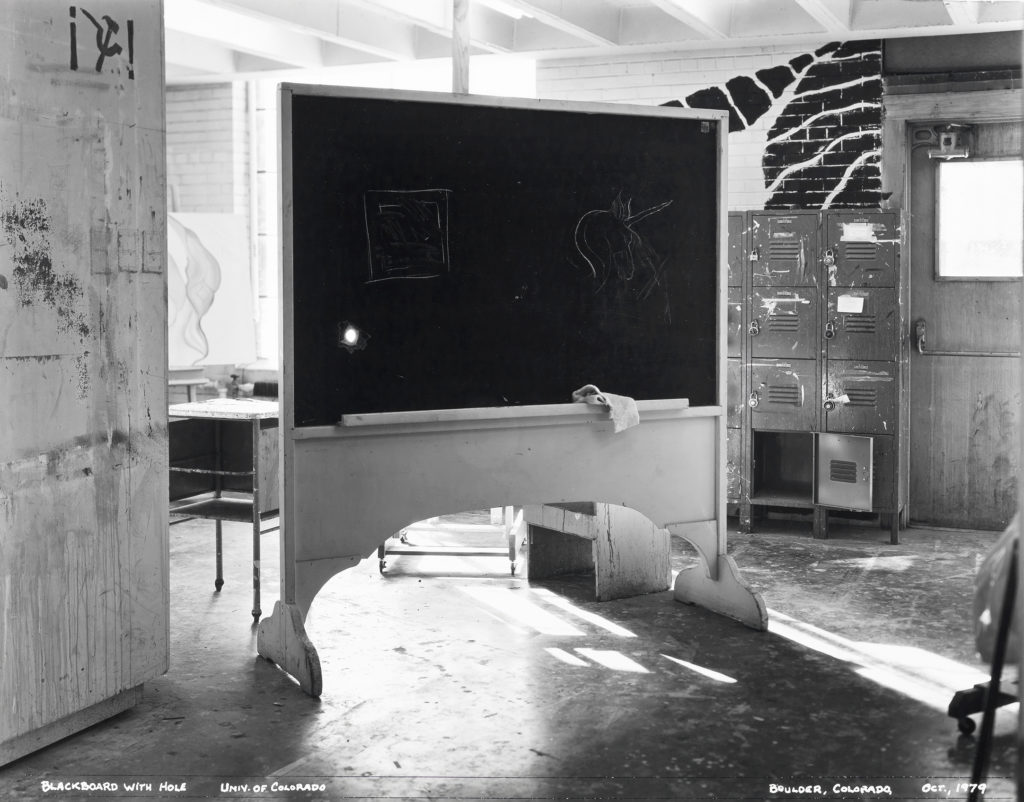
All images courtesy the artist/Licensed by VAGA, New York
Campany: So you made three or four paintings like this and just thought, Yep, I can do that?
Cumming: Yeah, despite the final result—it was unbelievably boring. So tedious being a human camera.
Campany: Having been making work for forty-five years or so, does it feel like you have circled around certain themes that whole time?
Cumming: Yeah, it does. Every once in a while, I’ll be just sort of sitting, looking at stuff, and suddenly—Oh, I’ll be damned, this connects to that.
Campany: You’ve never really kept still. But you mentioned the idea of becoming obsessed and I think that’s a clue to the way you’ve worked. You clearly have an awful lot of creative energy and curiosity, and the projects are there to get those obsessions out of your system—often in one work or a defined body of work—and then something else comes along. On top of that you have an awful lot of chops, as musicians would say, a lot of virtuosity with different materials that most artists don’t have, or don’t want to think about using.
Cumming: The last ten or fifteen years I’ve been doing figure drawing. Models and such. And the drawings are people in situations which go right back to A Training in the Arts.
Campany: Even going right back to those photographs of sculpture from the late ’60s, it seems that just about everything you’ve done has, at its core, the same kind of sensibility or the same kind of interest in the world around you, its objects, what those objects are, and how we perceive them.
Cumming: I would hope so, but it’s hard being your own art historian. In a magazine article, Chuck Hagen called the pictures “meditations.”
Campany: For all your obsessions and recurrent themes, the moment you feel you are repeating . . . you drop it. It’s almost as if those obsessions and themes are going to be there regardless of medium or technique.
Cumming: They are. I very seldom worry about it. Having gotten along these last forty years, I’m still here. Must be doing something right—I’m not exactly sure what it is. But there’s nothing more valuable, I think, than a person who really likes [the work]. It’s a mystery to me, but . . .
Campany: Well, I know your art has found a very youthful and engaged audience again.
Cumming: Oh, good.
This interview originally appeared in Robert Cumming: The Difficulties of Nonsense (Aperture, 2016).


























